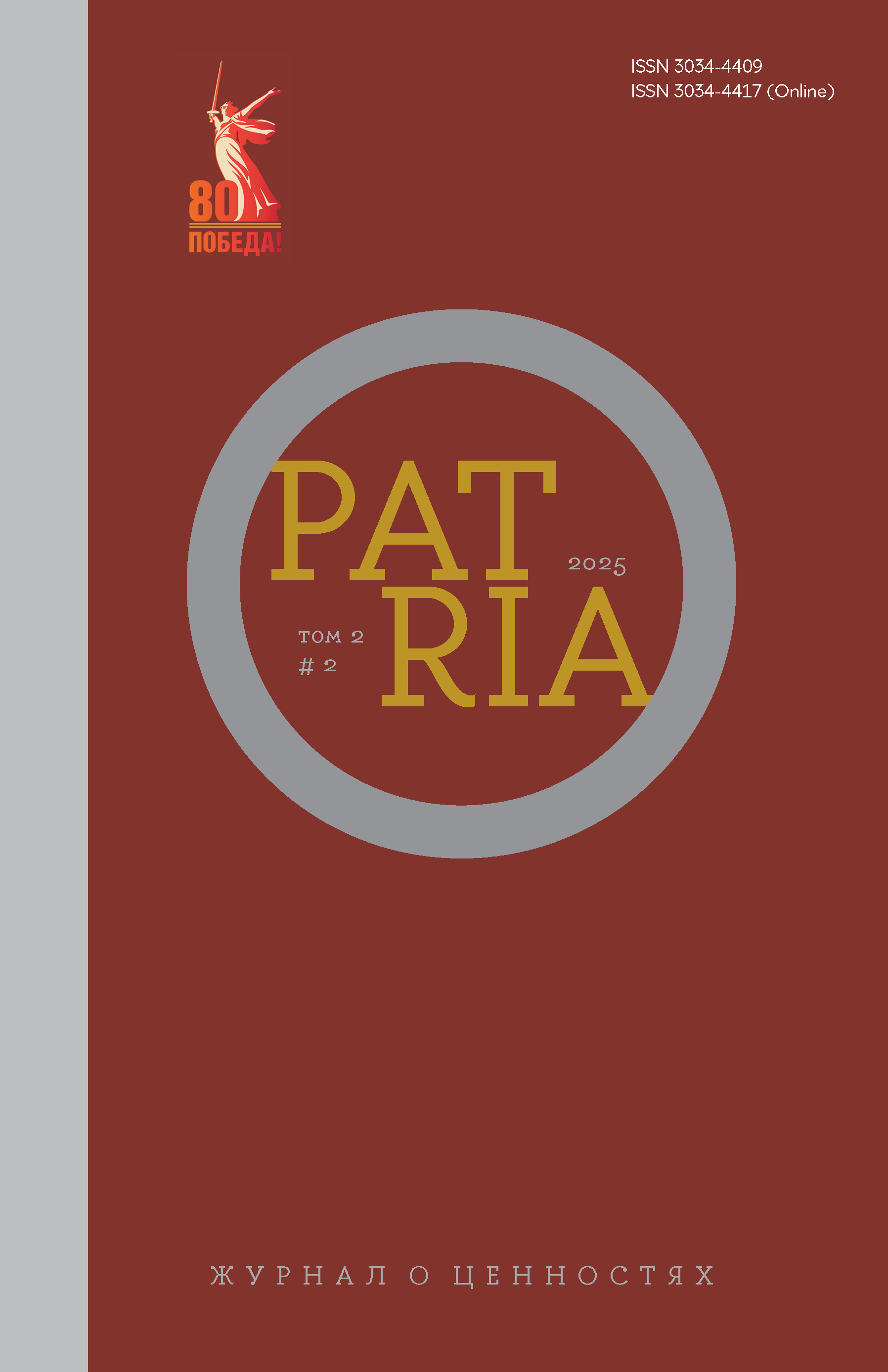-
26
-
10
-
7
-
7
-
6

Dear friends!
We are pleased to share with you the second issue of the second volume of the journal Patria. This issue is dedicated to Russian traditional values and timed to coincide with the 80th anniversary of the Victory in the Great Patriotic War.
The issue opens with its main topic — a block of articles directly devoted to the Great Victory.
Denis Artamonov (Saratov National Research State University named after N.G. Chernyshevsky) and Regina Penner (South Ural State University) in their article "The Value of the Great Victory: Emotional Optics" explore the role of emotions in shaping historical memory and axiological orientations related to the Victory in the Great Patriotic War in the era of post-truth. The authors emphasize that conflicts in the sphere of historical memory reflect not a clash of facts but a struggle of values rooted in emotions—pride, grief, and unity. Through the lens of emotional axiology and epistemology, the article reveals the role of rituals (parades, the Immortal Regiment), media, and art in maintaining an affective connection with the past. The philosophical foundation of the work draws on the ideas of Max Scheler, Pierre Nora, and Gilles Deleuze, demonstrating how emotions construct value realities and serve as mediators between the past and present. In the post-truth era, Victory is interpreted as "living memory," resisting the erosion of historical truth. The authors argue that emotional optics overcome the binary of rational and emotional, revealing memory as a hybrid process where official narratives, personal stories, and collective myths interact. Thus, the Great Victory remains not only a historical event but also an ethical benchmark uniting society in an era of informational instability.
The topic of the media's role in preserving the memory of Victory is further developed in Anton Zhigunov’s (Omsk State University named after F.M. Dostoevsky) article "‘Unknown and Familiar’: The Image of the Hero in the Context of Celebration of the Great Victory." Based on internet texts, the author examines the features of representing the image of the Great Patriotic War hero in contemporary mass (media and political) discourse—a key means of transmitting and shaping mass perceptions of the present and past. The article analyzes sociological measurements, media texts, and legal acts related to the hero's image, as well as interpretations of collective and individual memory by Maurice Halbwachs, Paul Ricœur, and Karl Jaspers, revealing the possibilities of their existence, formation methods, and degree of influence on individual perceptions of the events of 1941–1945. The author distinguishes between the personalized and unknown hero and differentiates the principles of image creation, the tools used, including commemoration practices.
Concluding the block of articles on Victory is a study that addresses a question naturally arising within the journal’s thematic framework: how can Victory in the Great Patriotic War, and the category of victory in general, be understood as a value? Yuri Vetyutnev (Volgograd State University) in his article "The Victory as a Value" argues that since value is nothing more than a preference given to one thing over another, the acquisition of value by any phenomenon presupposes that it has withstood a certain cultural competition. The author highlights the paradoxical nature of victory’s value: by demanding an end to confrontation, it negates the structure of value with its inherent tension. Yet, the search for a topos occurs only through disagreements resolved by the triumph of some ideas over others. The Great Victory of 1945 is a historical imprint of another round of axiological confrontation in the mid-20th century. The positions of individualistic worldview were somewhat shaken by the impressive demonstration of collectivism’s strength, while the softening of strictly atheistic stances, replaced by moderate mutual loyalty between the state and the church, could be seen as a relative victory of Christian ideals. The short-lived and fragile synthesis of these principles, soon subjected to new attacks, nevertheless became the basis of Russian culture’s value self-determination, which has yet to find a worthy replacement.
The subsequent articles in the issue are devoted to traditional values in the history of Russian thought.
In "Slavophile Conceptions of ‘Russian’ and ‘Russianness’ in the Late 1830s and thr First Half of the 1840s," Andrey Teslya (Immanuel Kant Baltic Federal University) introduces readers to the intellectual history of the concept of "narodnost" (national character) as key to Slavophile philosophy. This concept became central in Russian debates of the 1820s–1840s—first in literary criticism and later in official discourse. During this period, the term largely functioned as a question rather than denoting something relatively clear and defined; meanwhile, the Slavophiles’ immense contribution to concretizing the concept of "narodnost" in relation to Russia remains undisputed. The article focuses on the early period of Slavophilism—from the late 1830s, when the Slavophile circle began to form, to the mid-1840s, when Slavophilism produced texts perceived then and now as "manifestos" of the movement. The article analyzes texts by key Slavophile authors of the time: A.S. Khomyakov, Yu.F. Samarin, K.S. Aksakov, D.A. Valuev, and I.V. Kireevsky—demonstrating the directions in which the concept was concretized. Special attention is paid to the logic of identifying Orthodoxy as a constitutive characteristic of "Russianness" and the tensions within this construct.
Another episode from Russian intellectual history is addressed by Yulia Popova (College of Urban Entrepreneurs) in her article "‘From Marxism to Idealism’—and to the Religious Search: The Trajectory of Critical Marxists at the Beginning and the Third Quarter of the 20th Century." The article identifies a line of continuity between the periods of Russian critical Marxism mentioned in the title. The author shows how representatives of critical, or legal, Marxism (Sergei Bulgakov, Nikolai Berdyaev, Mikhail Tugan-Baranovsky) sought to supplement Marxism, or "economic materialism," with universal, humanistic, and Christian ethics, ultimately arriving at idealism, liberalism, disillusionment with Marxism, and, finally, religious thought. A similar trajectory was repeated in critical Marxism during the Thaw. After the dominance of official party ideology, philosophical circles, diverse interpretations, debates, expectations, and hopes for the future emerged once again, as at the turn of the 20th century. The intelligentsia in these circles turned to ethical, moral, and religious reinterpretations of Marxism. Critical Marxists Evald Ilyenkov and his student Genrikh Batishchev emphasized the role of a comprehensively developed, creative, and critically thinking individual. By the end of the Soviet project, critical Marxists increasingly spoke of self-improvement, interpreting revolutionary practice as personal growth and the struggle for universal "humanization" in the moral sense.
Zhou Laishun (Heilongjiang University), in "Problem Consciousness and System Construction: New Progress in the Study of Russian Silver Age Philosophy in China," introduces Russian readers to the current state of Russian philosophy studies in China. The author notes that Chinese scholars have been examining Silver Age philosophy since the 1930s, meaning it has been studied for about 100 years. Since then, Chinese researchers have conducted in-depth studies of problem consciousness, theoretical characteristics, system-building, critiques of modernity, and other themes in Silver Age philosophy. Although the Silver Age thinkers’ project ended in practical failure, their emphasis on the unique spiritual value of the individual and their rethinking and reconstruction of modernity remain theoretically and practically significant.
Working at the intersection of Russian intellectual history and contemporary issues, Rustem Vakhitov (Ufa University of Science and Technology, Ufa State Petroleum Technological University) revives several ideas of classical Eurasianists. In "Eurasianism of the 1920s as a Scientific and Theoretical Basis for the Current ‘Turn to the East,’" the author argues that Russia’s current pursuit of Eurasian integration has objective causes: the EU’s shift to green energy would have necessitated a reorientation toward the East in any case, and Russia, as a Eurasian power, has historical ties with post-Soviet states, China, India, Iran, and Turkey. The ideology of this turn, the author suggests, could be a creatively developed Eurasianism. The Eurasianists of the 1920s (P.N. Savitsky, N.S. Trubetskoy, and others) substantiated the idea that Russia is neither Europe nor Asia but Eurasia—a synthetic civilization with Eastern roots. P.N. Savitsky demonstrated the trade benefits of an Eastern alliance, while N.S. Trubetskoy emphasized the need for Russian civilization’s self-knowledge and the identification of its non-European, Eastern origins.
Concluding the research block is Ilya Kanaev’s (Shandong University, Sun Tzu Institute) article "The Historical Development of Russia’s Traditional Values." Drawing on anthropology, cognitive science, and philosophy, the author theoretically justifies the necessity of maintaining a system of traditional values for a state’s existence and sustainable development. Applying these findings to Russian history clarifies the evolutionary nature of the Russian people’s collective identity. Close interaction with Western and Eastern cultures allowed Russia to synthesize a unique value system combining love for the Motherland and service to the Fatherland with mercy and humanity toward all people. The ability to hold such disparate moral principles in individual and collective consciousness was made possible by the constant need for new solutions and creative labor. In turn, creativity enables overcoming limitations, shaping the values of creation and will.
The review section, as usual, is also tied to the issue’s theme, featuring Konstantin Belov’s (National Research University Higher School of Economics) response to Maria Marey’s monograph on the political projects of late Slavophiles. The review introduces readers to the book’s structure, main ideas, and conclusions.
We would like to note that our journal features authors from across Russia—in this issue alone, they represent Saratov, Chelyabinsk, Omsk, Volgograd, Kaliningrad, and Ufa. The issue also includes a small presence from Moscow and Jinan (China), among other countries. In a way, this underscores how the journal’s main themes unite Russia. The fact that leading scholars from the regions choose Patria as their platform is invaluable. On behalf of the editorial board, I would like to thank all authors whose works have already graced our pages and those yet to come. We eagerly await your submissions.
We dare hope that the materials in this issue will prove interesting and enlightening, as well as contribute to the broader celebration of the 80th anniversary of the Victory over Nazism—an event whose significance for Russia and the world cannot be overstated. We congratulate all our readers on this commemorative date, bow our heads to the heroes’ feat, and wish everyone peaceful skies above.


